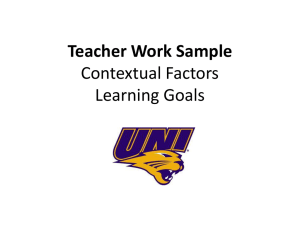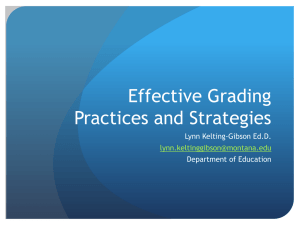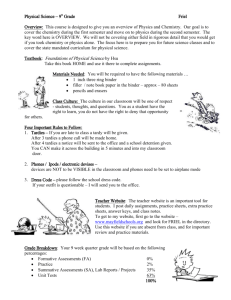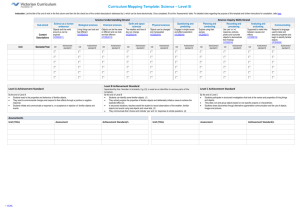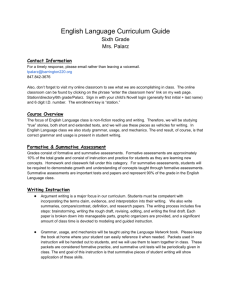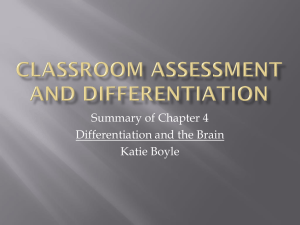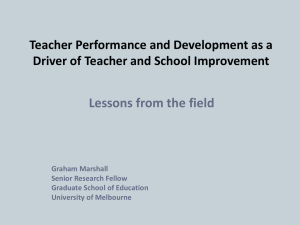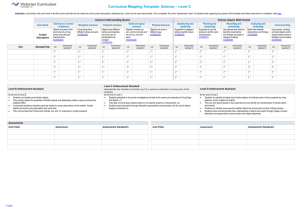DEPARTMENT OF EDUCATION UNIT PLAN TEMPLATE
advertisement
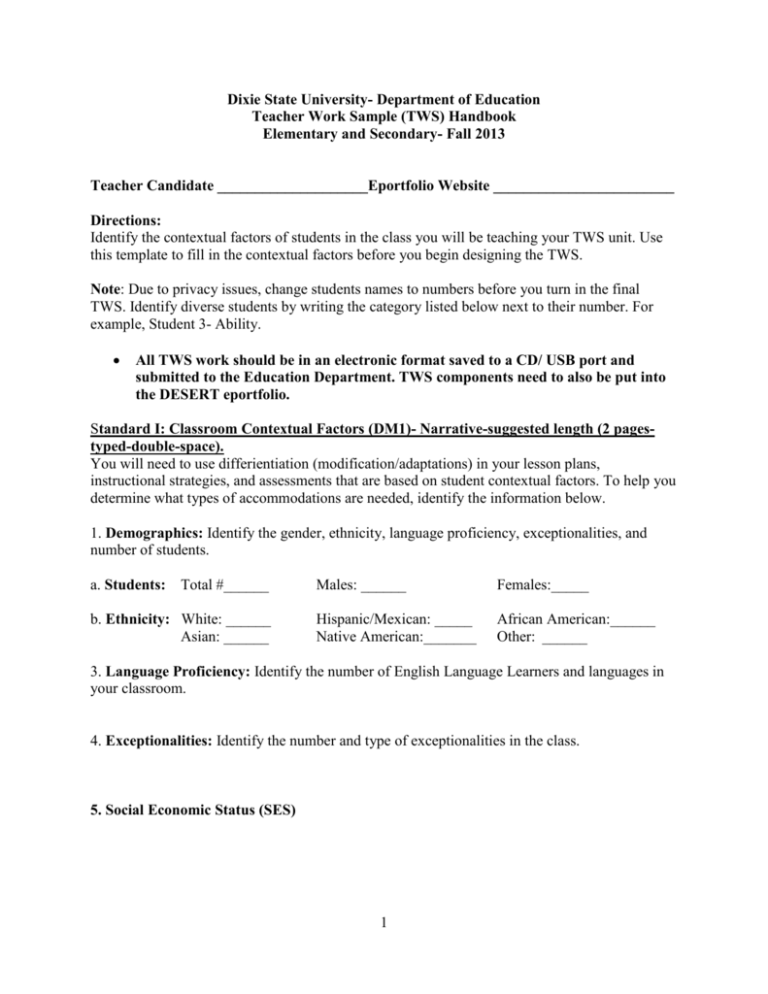
Dixie State University- Department of Education Teacher Work Sample (TWS) Handbook Elementary and Secondary- Fall 2013 Teacher Candidate ____________________Eportfolio Website ________________________ Directions: Identify the contextual factors of students in the class you will be teaching your TWS unit. Use this template to fill in the contextual factors before you begin designing the TWS. Note: Due to privacy issues, change students names to numbers before you turn in the final TWS. Identify diverse students by writing the category listed below next to their number. For example, Student 3- Ability. All TWS work should be in an electronic format saved to a CD/ USB port and submitted to the Education Department. TWS components need to also be put into the DESERT eportfolio. Standard I: Classroom Contextual Factors (DM1)- Narrative-suggested length (2 pagestyped-double-space). You will need to use differientiation (modification/adaptations) in your lesson plans, instructional strategies, and assessments that are based on student contextual factors. To help you determine what types of accommodations are needed, identify the information below. 1. Demographics: Identify the gender, ethnicity, language proficiency, exceptionalities, and number of students. a. Students: Total #______ Males: ______ Females:_____ b. Ethnicity: White: ______ Asian: ______ Hispanic/Mexican: _____ Native American:_______ African American:______ Other: ______ 3. Language Proficiency: Identify the number of English Language Learners and languages in your classroom. 4. Exceptionalities: Identify the number and type of exceptionalities in the class. 5. Social Economic Status (SES) 1 6. Academic Knowledge (If available): Describe the academic data results of the students thus far (grades, attendance, discipline factors, core tests. etc.). 7. English Language Learners: Describe ways you can incorporate tools of language development and reading content into planning and instruction for these students. Example: ELED- SIOP/ WIDA; SCED-reading content. 8. Multicultural Perspectives: Identify ways you can use culturally responsive curricula and teaching that meets the needs of all students. 9. Prior Knowledge: Elementary-Describe the criteria used to determine the reading and mathematics prior knowledge and give a percentage of the number of students in these different levels for reading and mathematics such as Below, Basic, or Advanced. Secondary- Review the prior knowledge needed of students to be successful in learning the content knowledge for the TWS unit and how you will implement content reading into your unit (Ex. Common Core Strategies, etc.). 10. Exceptionalities: Describe student exceptionalities that are identified in the class contextual factors. These exceptionalities can include; (a) development of physical, social, and emotional needs; (b) special education; (c) ethnicity; (d) gifted/talented; (e) ability differences, etc. Briefly describe ways to make modification/ differentiation for planning, instruction, and assessments. 10. Identify sub-groups of students: Based on your contextual class factors- identify the subgroups you will need to address in differentiation/modifications for your instruction, assessments, and analysis of student learning (e.g., gender, ELL, special education, ethnicity, gifted/talented, ability differences, or other contextual factors listed above, etc.) Subgroup data will be compared to each subgroup and the whole class. 2 Standard II: Unit Plan (DM2): Elementary or Secondary The unit plan must include Utah Core Standards and objectives (http://www.uen.org)/ Make sure all instruction, activities, accommodations for diverse learners, assessments, and materials support your goals and objectives for the unit. You will be required to use multiple assessments (formation and summative) in each lesson along with a unit pre-test, recommendation use of quantitative data (e.g., multiple choice, true/false or fill-in, etc.), given before teaching the TWS unit and using this same pre-test as a posttest after the unit teaching is completed. These objectives and assessments will be used to determine students' progress toward the unit learning goals. Listed below is an elementary unit plan with template. Secondary unit plan template is listed on pages 6-7. DIXIE STATE UNIVERSITY – DEPARTMENT OF EDUCATION UNIT PLAN TEMPLATE Semesters 3 & 4 ***PLANNING TEMPLATE*** Teacher Candidate _________________Grade Level ________Content Area __________ Step 1 – DESIRED RESULTS A. Contextual Factors Describe the demographics of the classroom (race/ethnicity, gender, IEP, ELL, GATE, etc.). Describe the academic data results of the students thus far (grades, attendance, discipline factors, etc.) B. Utah State Core or Common Core Curriculum Standard Provide the core standard as written by USOE (Include pertinent standard and objectives for this unit) C. The Enduring Understanding/Big Idea is: Aligned with the core standard. Is written in student-friendly language (can the students understand it?). The key generalization or enduring understanding students will take with them. Identifies the larger concepts you want students to wrestle with and understand at a deep level across time and cultures. Is brief (5-10 words is best). Is conceptual D. Essential Questions/Guiding Questions are: Are used to guide assessments and instruction. Invite students into the learning process. Are open-ended, yet focus inquiry into a specific topic. Non-judgmental, but answering them requires high-level cognitive work. Succinct – a few words that demand a lot. Contain “emotive force” and “intellectual bite” (e.g., Whose America is it? When are laws fair?) E. Concepts Based upon the Utah State Core or Common Core standard, what do students need to know? 3 F. Skills Based upon the Utah State Core or Common Core standard, what will students be able to do Step 2 – ASSESSMENT EVIDENCE A. Pre-Assessments Aligns with enduring understanding/big idea and key concepts and skills. Aligns closely with standard (criterion-reference). If applicable, includes the scoring guide/rubric. Include your pre-test for the unit. B. Formative Assessments/Evidence Aligns with all key concepts and skills. Aligns closely with standard (criterion-reference). Includes scoring guides/rubrics. C. Summative Assessments/Evidence Aligns with enduring understanding/big idea and comprehensive concepts and skills. Aligns closely with standard (criterion-reference). If applicable, includes scoring guide/rubric. Include your posttest for the unit. Step 3 – INSTRUCTIONAL STRATEGIES/LEARNING ACTIVITIES Identifies each lesson objective that completely align with the standard, then lists the instructional strategies and learning activities that will provide students with the information and activities that will allow them to proficiently understand the enduring understanding/big idea and are aligned with the standards-based assessments. Makes certain that strategies are developmentally appropriate for the age and grade-level. Utilizes research-based strategies that produce high-yield results. Utilizes expository and persuasive writing. Focuses on strategies and learning activities that have the students actively do the content. Adapted from: McTighe, J., & Wiggins, G. (2005). Understanding by design, 2nd ed. Alexandria, VA: ASCD.; Ainsworth, L. (2003). Unwrapping the standards: A simple process to make standards manageable. Denver, CO: Advanced Learning Press. 4 DIXIE STATE UNIVERSITY – DEPARTMENT OF EDUCATION UNIT PLAN TEMPLATEElementary Semesters 3 & 4 Teacher Candidate ______________________Grade Level ______ Content Area _________ Step 1 – DESIRED RESULTS A. Contextual Factors B. Utah State Core or Common Core Curriculum Standard C. Enduring Understanding/Big Idea D. Essential Questions/Guiding Questions E. Concepts F. Skills Step 2 – ASSESSMENT EVIDENCE 1. Pre-Assessments 2. Formative Assessments/Evidence 3. Summative Assessments/Evidence Step 3 – Lesson Objectives with Instructional Strategies 5 SECONDARY UNIT PLAN TEMPLATE Stage 1 – DESIRED RESULTS Content Standards & Goals Transfer Students will be able to independently use their learning to… Meaning UNDERSTANDINGS Students will understand that… ESSENTIAL QUESTIONS Students will keep considering… Acquisition Students will know… 6 Students will be skilled at… Stage 2 – EVIDENCE PERFORMANCE TASK(S): Students will show that they really understand by evidence of… PERFORMANCE TASK(S) CRITERIA: The performance task will be evaluated by… OTHER EVIDENCE: Students will show they have achieved Stage 1 goals by… Stage 3 – LEARNING PLAN PRE-ASSESSMENT: MAJOR LEARNING EVENTS: Student success at transfer, meaning, and acquisition depends upon… PROGRESS MONITORING: Source: Wiggins, G, & McTighe, J. (2010). The Understanding by Design Guide to HighQuality Units. Alexandria, VA: ASCD. 7 Standard III: Lesson Plans (DM2): Lesson Plan Template Elementary and Secondary It is required to have a minimum of six lessons for the TWS. Include in your appendix any worksheets, handouts, scoring guides, and/or rubrics for each assessment (tests, questions, etc.). Secondary lesson plan template is listed on pages 11-12. DIXIE STATE UNIVERSITY – DEPARTMENT OF EDUCATION ELEMENTARY 4th SEMESTER & STUDENT TEACHING LESSON PLAN TEMPLATE (1/25/13) Teacher Candidate _____________________________ Grade Level _______Title__________________ CONTEXTUAL FACTORS (classroom factors) Contextual Factors: Classroom environment: WALK-AWAY (As a result of this lesson, what do I want the students to know, understand, and be able to do?) State Standard/Objective: Content Walk-Away: Language Walk-Away: Vocabulary: ASSESSMENT EVIDENCE (What evidence do I need to show the students have learned the Walk-Away?) Formative Evidence (checking for understanding throughout the lesson): Content Walk-Away Evidence (Summative): Language Walk-Away Evidence (Summative): 8 Modifications/Accomod ations (ELL, IEP, GATE, etc.) Approx. Time ACTIVE LEARNING PLAN Activate/Building Background Knowledge Formative assessment: Learning Goal Success Criteria Assessment Strategy Modification/accommodations: (ELL, IEP, GATE, etc.) Focus Lesson (“I do it”) Formative Assessment: Learning Goal Success Criteria Assessment Strategy Success Criteria Assessment Strategy Modification/accommodations: Guided Instruction (“We do it”) Formative Assessment: Learning Goal Modification/accommodations: Collaborative/Cooperative (“You do it together”) Formative Assessment: Learning Goal Success Criteria Assessment Strategy Modification/accommodations: Independent (“You do it alone”) Summative Assessment: Modification/accommodations: Closure/Review of walk-aways, vocabulary, and essential questions (Note: Closure includes student interactions, reflection, and/or demonstrations.) 9 SIOP Indicators (Add SIOP number and description within the lesson plan) Preparation: 1-Content objectives, 2-Language objectives, 3-Content appropriate, 4-Supplementary materials, 5Adaptation of content, 6-Meaningful activities Building Background: 7-Linked to background, 8-Linked to past learning, 9-Key vocabulary Comprehensive Input: 10-Appropriate speech, 11-Clear explanation, 12-Variety of techniques Strategies: 13-Students use learning strategies, 14-Scaffolding, 15-Higher-order thinking, Interaction: 16-Opportunity for interaction, 17-Grouping supports objectives, 18-Wait time, 19-Opportunity for L1 students Practice/Application: 20-Hands-on materials, 21-Activities to apply content/language knowledge, 22-Language skills: reading, writing, listening, speaking Lesson Delivery: 23-Content objective supported, 24-Language objective supported, 25-Students engaged, 26Pacing Review/Assessment: 27-Review vocabulary, 28-Review concepts, 29-Feedback, 30-Assessment TEACHING NOTES What do I need to remember to do? What materials do I need to have ready? What is the approximate time needed for this lesson? REFLECTION AFTER LESSON How can I use the assessment data to reflect on & evaluate the outcomes of teaching and learning? How can I transfer what I learned from teaching this lesson to future teaching? What was effective and not effective? What goals can I set to improve my practice and student learning? 10 LESSON PLAN TEMPLATE -SECONDARY Teacher Candidate ____________________________________________________________________________ Grade Level ________ Subject/Content:________________Title _______________________________________ CONTEXTUAL FACTORS (e.g. ethnicity, gender, exceptionalities, ELL, GATE, etc.) which need differentiation in instruction and assessment. WALK-AWAY (what do I want students to know, understand, and be able to do?) Content Walk-Away: Reading/Language Walk-Away: ASSESSMENT EVIDENCE (formative/summative checks for learning) (Match the Content Walk-Away) 11 Modifications/Accommodations (ELL, IEP, GATE, etc.) ACTIVE LEARNING PLAN Modifications/ Accommodations (ELL, IEP, GATE, etc.) Activate Prior Knowledge/Experiences Focus Lesson (“I do it”) Guided Instruction (“We do it”) Collaborative/Cooperative (“You do it together”) Independent (“You do it alone”) Summarization/Closure NOTES TO TEACHER What do I need to remember to do? Materials to have ready? Approximate time needed for lesson? 12 Standard IV: Analysis of Student Learning (DM2)-Narrative-suggested length (2-3 pages). Student scores will be reported as individual, whole class, and sub-groups which are based on contextual factors. All scores will be presented in a table and analyzed. Data Table and Graph Create a table or chart of data (pre and post-test scores) from each student and the whole class. Remember to use the student numbers and categories for diverse learners- no names. Create a graph which provides a visual representation of the data. This can be done by using Microsoft excel. Include a different color on your graph for sub-group students. Below is an example of charts of and graphs. Analysis of Data Include in your discussion these key points. A summary of individual student performance on a variety of assessments. Explain how evidence from the assessments supports or contradicts pre-test, post-test, formative/ summative assessments related to student learning. Use assessment data to draw conclusions about the learning of ALL students through the evaluation of student performance on the objectives. Discuss the assessment instruments to determine the validity of questions used in assessments to measure student learning. Disaggregates data to make informed conclusions about each subgroup's and all student learning relating to core standards and objectives. 13 Standard V: Reflection and Self-Evalution (DM4)- Narrative-suggested length (1 1/2 to 2 pages-typed-double-space). Reflect on your performance as a student teacher and link your performance to student learning results. Address the components in your discussion. DM1- Diversity Describe how you used culturally responsive curricula/multicultural education in your TWS lessons and instruction. DM2-Effective Pedagogy Explain how technology was used to support instruction and extend student learning. DM3-Subject Matter Evaluate your confidence and subject matter knowledge when teaching this TWS unit. DM4- Environment Describe how you created a physically and emotionally safe classroom environment. Evaluate your classroom management strategies and describe what was effective and ineffective. DM5-Reflection Describe how the data from this TWS has helped you evaluate outcomes of teaching and student learning. DM6- Teaching Dispositions Describe personal growth and learning during this teaching experience. Describe caring and professional relationships with students/parents/colleagues and its impact on student learning. Standard VI. TWS Organization, Structure, and Writing (DM6) Components include; (a) cover page with name, title of unit, dates taught, grade level, and subject. Table of Contents Appendix A: Reference list (APA style) for resources that were used in the curriculum design process. Appendix B: Pre/Post-tests, formative assessments, etc. Appendix C: Select one assessment example from three students, who were in the sub-group category identified in your contextual factors, and scanned their work (black out their names and identify them through student number and diverse category letters) and attach it to appendix C. Writing: Grammatically and mechanically correct; work is neat and professional in appearance.DM6- Teaching Dispositions. 14
